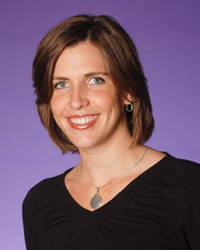Although many universities have lecture courses with enrollments of 500 or even more students, TCU does not have any courses with such massive enrollment. In fact the TCU average student faculty ratio is a remarkably low 13:1. This size allows faculty to know most students reasonably well by the end of a semester. However, even in these large courses by TCU standards, faculty find it difficult not only to learn names but to encourage active participation. How can faculty engage students in such classes?
Dr. Amanda Irvin of the Center for Teaching Excellence suggests that faculty arrive early to class or stay a few minutes late to visit with individual students. Additionally, faculty can record a student’s name and make notes on index cards to document personal conversations that take place. Later faculty can follow-up with the student by email and reference particular conversations.
Dr. Keith Whitworth utilizes the space in a lecture hall to make a larger classroom feel smaller. “I walk up and down the aisles of SWR Lecture Hall 1. This at least brings me closer to the students in the lecture hall. I can also view whether they are on Facebook, checking scores on ESPN, or surfing the web for a new pair of shoes.” Recently Whitworth taught 150 students in his Sustainability: Environmental, Economic, & Social Justice Issues course. “It is difficult to connect with 150 students,” he explained. Whitworth went on to say that one of the biggest challenges in teaching a large course is the ease with which students can become anonymous, “This anonymity provides the perfect cover for students to zone out or to use their laptops or phones for non-course purposes.”
To better facilitate discussions, professors can create zones and call on students in different zones to answer questions or take part in a specific part of the discussion. Whitworth uses a dozen portable white boards and breaks students into groups. The students are familiar with the exercise and will break into group upon Whitworth’s direction. The groups rotate, discuss topics, and write one to three words on their board. One member from each group is asked to come to the front of the classroom and hold up the group’s board. The class then discusses the similarities and differences of the words on each board as they relate to the topic. Whitworth explains, “This keeps the students engaged and moving around.”
Dr. Clark Jones teaches 72-96 students in Microbiology each spring and fall, respectively. Jones admits the most difficult aspects of teaching large classes are encouraging student interaction and determining if students understand key concepts. Jones shared, “My class is at 8:00 AM, so a typical monotonous lecture will not work.” Jones begins each lecture with announcements and iClicker questions to review the previous lecture material. “I ask questions during class for verbal participation and encourage questions and the sharing of personal experiences. I use current news events, break-through technologies, clinical applications, and everyday life occurrences to introduce difficult concepts and show how microbiology is occurring every moment of every day in each of their lives.”
Faculty may experience success and failure with different approaches. Clark Jones stated, “I try new approaches all of the time and if the students become more engaged, those techniques become part of the course.” Additionally, engagement strategies that work for a one course may not work for another. Dr. Gail Jones shared that in her BIOL 10003 class of 90 students, iClickers were viewed positively by the students. However, she reported that the semester she tried a similar approach with iClickers in her upper-level Biochemistry class, “most of the students considered it a bother. I think they felt like they were being treated as freshmen.”
Rather than cramming a lecture with everything there is to know, faculty must discern what is necessary and applicable to students and teach them to evaluate information critically. Clark Jones offers this advice, “There is so much information today that it is impossible to teach everything. But a well-organized course filled with student engagement, instead of student passiveness, can excite and engage students no matter how large the size of the classroom. “

This article was written by Gina Hill, Department of Nutritional Sciences, for the Fall 2014 Issue of Insights Magazine.